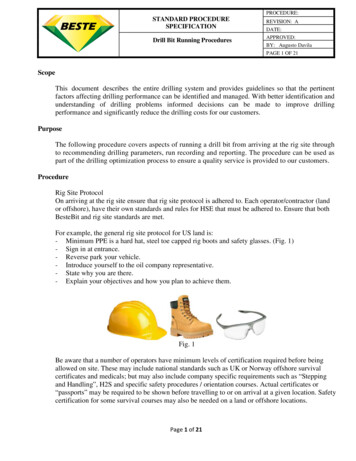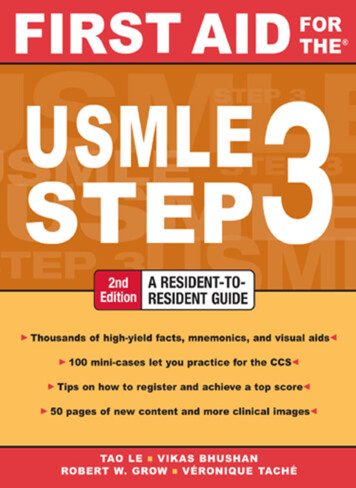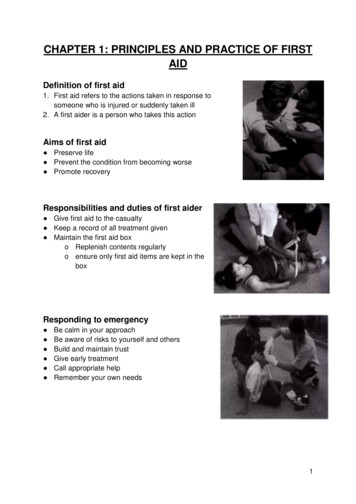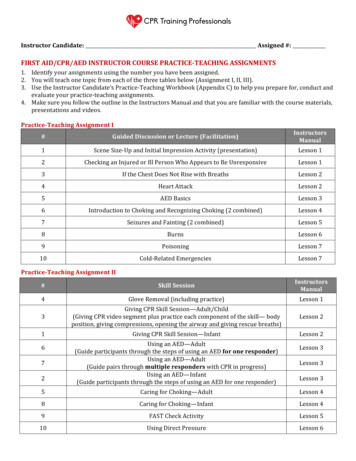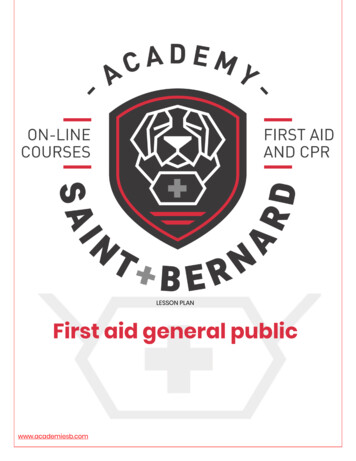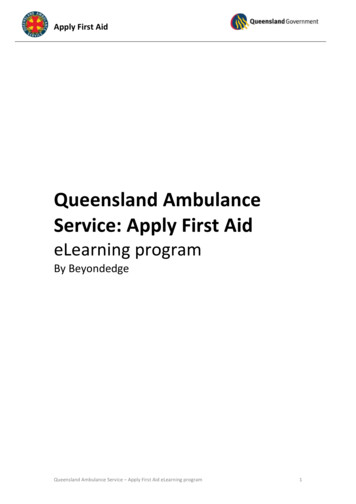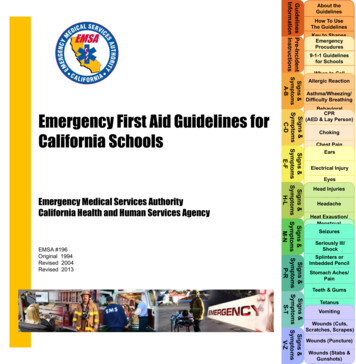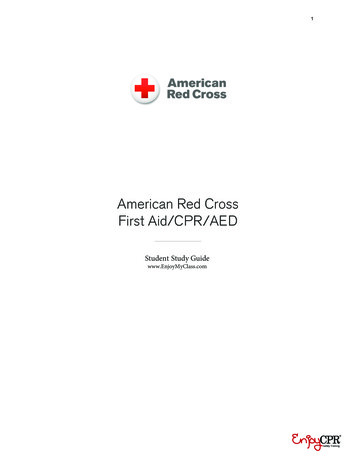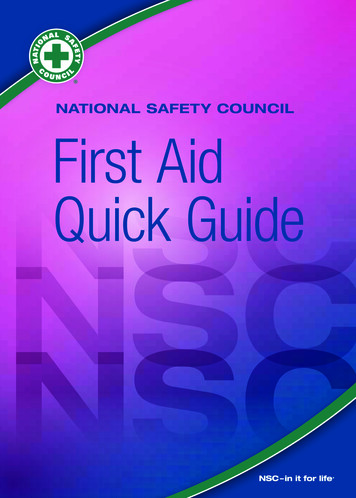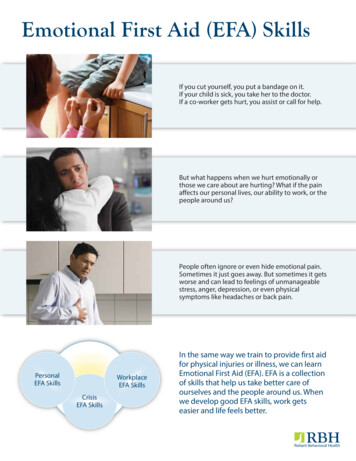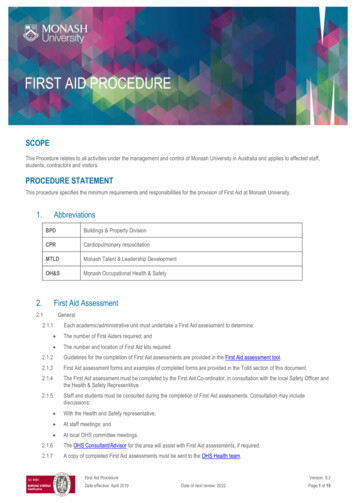
Transcription
FIRST AID PROCEDURESCOPEThis Procedure relates to all activities under the management and control of Monash University in Australia and applies to affected staff,students, contractors and visitors.PROCEDURE STATEMENTThis procedure specifies the minimum requirements and responsibilities for the provision of First Aid at Monash University.1.AbbreviationsBPDBuildings & Property DivisionCPRCardiopulmonary resuscitationMTLDMonash Talent & Leadership DevelopmentOH&SMonash Occupational Health & Safety2.First Aid AssessmentGeneral2.1.1Each academic/administrative unit must undertake a First Aid assessment to determine: The number of First Aiders required; and The number and location of First Aid kits required.2.1.2Guidelines for the completion of First Aid assessments are provided in the First Aid assessment tool.2.1.3First Aid assessment forms and examples of completed forms are provided in the Tolld section of this document.2.1.4The First Aid assessment must be completed by the First Aid Co-ordinator, in consultation with the local Safety Officer andthe Health & Safety Representitive.2.1.5Staff and students must be consulted during the completion of First Aid assessments. Consultation may includediscussions: With the Health and Safety representative; At staff meetings; and At local OHS committee meetings.2.1.6The OHS Consultant/Advisor for the area will assist with First Aid assessments, if required.2.1.7A copy of completed First Aid assessments must be sent to the OHS Health team.First Aid ProcedureDate effective: April 2019Version: 9.3Date of next review: 2022Page 1 of 15
First Aid assessments must be reviewed every three years and in addition whenever:2.1.8 The size and/or layout of the area is changed; The number and distribution of staff and/or students (or others) changes significantly; There are changes in hours, overtime, shifts; or The nature of the hazards and the severity of the risks change.First Aid considerations for Off-Campus activitiesFirst Aid requirements must be included in the OHS risk assessment, contextualised for the specific off-campus activity. Further detailsof factors that should be considered, are provided in the OHS Off-Campus Activities and Travel Procedure.2.2.1Urban areasFor off campus activities to places where emergency First Aid or medical services are available e.g. shops, museums,factories hospitals or other universities, there is no requirement to provide a Monash First Aider.2.2.2Low risk activities All low risk activities must include one Level 2 trained First Aider. It may be necessary to increase the number of First Aiders dependent on the outcome of the OHS risk assessment for theactivity. Guidelines for minimum numbers First Aiders are provided in the First Aid assessment tool.2.2.3 2.2.4High risk activitiesDue to the increased level of risk, the number of First Aiders must conform to the guidelines provided for off-campusactivities in rural areas in the First Aid assessment tool.Rural Areas Off-campus activities in rural areas should include as many First Aiders as practicable and these must be trained to at leastLevel 2. Guidelines for minimum numbers of First Aiders for off-campus activities in rural areas can be found in the First Aidassessment tool. It may be necessary to alter the number of First Aiders and level of qualification, e.g. Remote Area First Aid required,dependent on the outcome of the OHS risk assessment for the activity. Whenever practical, First Aiders should not travel in the same vehicle. For additional information regarding off campus activities refer to the OHS Off-Campus Activities and Travel Procedure.2.2.5Remote areas It may be necessary to alter the number of First Aiders and level of qualification, e.g Remote Area First Aid required, asdetermined in the OHS risk assessment for the activity. Guide lines for minimum numbers of First Aiders for off-campus activities in remote areas are provided in the First Aidassessment tool. It is recommended that a least one person trained in Mental Health First Aid or an equivalent course attends rural/remoteoff-campus activities. Information about Mental Health First Aid courses is provided on the myDevelopment website. Whenever practical, First Aiders should not travel in the same vehicle. For additional information regarding off campus activities refer to the OHS Off-Campus Activities and Travel Procedure.2.2.6International activities For international activities, which are based at an overseas campus of Monash University, e.g. Prato, Malaysia or at otheruniversities/organisations that provide First Aid, there is no requirement to provide a First Aider from Australia. For international activities in urban, rural or remote areas, the requirements as outlined in sections 2.2.1 - 2.2.5 apply.First Aid ProcedureDate effective: April 2019Version: 9.3Date of next review: 2022Page 2 of 15
3.First AidersNumber of First Aiders required3.1.1The number of First Aiders is determined by undertaking an assessment as outlined in Section 2.3.1.2Guidelines for determining the number of First Aiders are provided in the First Aid assessment tool.Requirements for First Aiders3.2.1Staff who wish to act as Monash Univeristy First Aiders must: Have a keen interest in First Aid; Be prepared to participate in a Hepatitis B immunisation program; Be appointed to the role of their own free will; Be able to be called away from their ordinary work at short notice; Feel free to relinquish the role of First Aider if they so wish; Be readily available when required; Be able to be released from their duties to undertake training in order to maintain skill levels; Be able to relate well to staff and students; Have the capacity to deal with injury and illness; and Be committed to undertake regular update training and information sessions.Procedures for contacting First Aiders3.3.1Each academic/administrative unit must have procedures in place to ensure that First Aiders can be promptly contacted inan emergency including after-hours where applicable (i.e. Security staff who are all First Aid trained and have access to aportable defibrillator).3.3.2These procedures can include:Signs to First Aid stations where First Aiders: Are present; and/or Can be contacted or located.Lists of First Aiders and contact details clearly displayed: By phones; On emergency procedure notices; On First Aid kits; On safety noticeboards.3.3.3These procedures must be current, i.e. lists and signs must be kept up to date.3.3.4All staff must be made aware of procedures for contacting First Aiders and any changes to them.4.First Aid TrainingFirst Aid qualificatins4.1.14.1.2First Aiders will be considered appropriately qualified provided that they: Complete a First Aid certificate , minimum “Provide First Aid” (previously Level 2 First Aid); Renew their Provide First Aid certificate every three years; Attend a cardiopulmonary resuscitation (CPR) training session at least once per year. (If desired, First Aiders arewelcome to attend two CPR sessions per year.)The cost of attendance at training courses will be met by the academic/administrative unit.First Aid ProcedureDate effective: April 2019Version: 9.3Date of next review: 2022Page 3 of 15
4.1.3Staff or students with First Aid qualifications obtained outside the University can be accepted as First Aiders on verificationof their certificate by the OHS Health team.First Aid training4.2.1Monash Talent & Leadership Development (MLTD) organises First Aid training courses specifically tailored for MonashUniveristy on all campuses.4.2.2Information regarding the content and scheduling of OHS courses offered at Monash University is provided on themyDevelopment website.First Aid courses offered include: Provide First Aid (previously Level 2) CPR training4.2.3More specialised First Aid courses offered upon request include: Provide Advanced First Aid (Level 3) Remote area First Aid Emergency asthma management Oxygen therapy First Aid management of Anaphylaxis4.2.4Additional specific training modules can be requested to customise courses for specific needs of academic/administrativeunits.4.2.5Monash Talent and Leadership Development (MTLD) issues reminder notices for all First Aid training facilitated by MTLD.4.2.6MTLD maintains a database of First Aiders who have undergone training. This information can be obtained by contactingMTLD.Note:In some instances qualified medical professionals (e.g. medical practitioners, registered nurses) may be exempt from FirstAid training. It will be necessary to liaise with the OHS Health team to discuss possible exemption. In addition, they musthave been approved by their supervisor to act in an official capacity as a First Aider (refer also to section 13).5.Infection controlHepatitis B Immunisation5.1.1All new First Aiders and First Aiders undertaking renewal training who act as Monash University First Aiders mustcomplete, or have completed, a Hepatitis B immunisation course as they may be inadvertently exposed to risk whileassisting a patient.5.1.2Further information is available in the Immunisation Procedure and the OHS Information Sheet: Hepatitis B immunisationfor First Aiders.Standard Precautions5.2.1First Aiders must use good hygiene and standard precautions, as taught during First Aid training, to minimise theirexposure to human blood and body fluids.5.2.2It must be assumed that all human blood or body fluids are potentially infectious.5.2.3Small spots of blood/body fluid spills must be cleaned up as instructed in the First Aid course. For larger spills contact theManager, Cleaning Services at your campus or local Biosafety Officer so that appropriate cleaning can be organised.5.2.4Used dressings must be placed in a biohazard bag and the area’s OHS Consultant/Advisor or Biosafety Officer contactedregarding appropriate disposal.Disposal of needels and syringes5.3.1It is not the First Aiders duty to dispose of needles and/or syringes. If these are found, the area must be secured andSecurity contacted so that appropriate disposal can be organised.Infection control and emergency resuscitationFirst Aid ProcedureDate effective: April 2019Version: 9.3Date of next review: 2022Page 4 of 15
5.4.1There is no reason to deny anyone resuscitation. The decision whether to use direct mouth-to-mouth resuscitation is up toeach First Aider.5.4.2Where possible, First Aiders must use either the individual resuscitation masks issued to them during their training or themask kept in each First Aid kit.6.First Aid Documentation and Reporting ProcedureFirst Aid injury reports6.1.1First Aiders must record all treatment (however minor) on the First Aid Injury Report.6.1.2First Aid Injury Report forms should be available near the First Aid kit.6.1.3Further supplies of the report forms can be obtained from the OHS website.Reporting Procedure Casualty is treated by First Aider for injury/illness; First Aid injury report is completed by First Aider; First Aid injury report must be sent to the Occupational Heath Nurse Consultant, OH&S at the Clayton campus. Wheninjury/illness is related to work, the casualty should be encouraged to complete an online Hazard & Incident Report inSARAH as soon as they are well enough.7.First Aid KitsNumber of First Aid kits7.1.1The number of First Aid kits is determined during the First Aid assessment (see section 2).7.1.2Guidelines for determining the number of First Aid kits are provided in the First Aid kit guide.First Aid kits must: Be accessible at all times (e.g. not located behind a locked door or in a locked cupboard); In general, must not be locked. When First Aid kits are located in areas accessible to the public and are subject to pilfering,they may be locked, with key access provided by an adjacent break glass system so that the kit is immediately accessible; Have a white cross on a green background prominently displayed on the outside; Be sturdy, dust and moisture proof, coated inside and out with an impervious finish; Be located at a known First Aid station. Each First Aid station will be clearly signposted with the kit positioned in theimmediate area; and Be large enough to accommodate additional modules where they are needed, preferably in separate compartments.Contents of First Aid kits7.3.1The contents of First Aid kits will need to vary depending on the nature of the hazards in the area as indicated by the FirstAid assessment.In some circumstances i.e. for off-campus trips, small portable First Aid kits may be more appropriate.7.3.2First Aid kits must not contain antiseptics or medications. Additional modules are available if a First Aider has beenspecifically trained in their use e.g. Ventolin, adrenaline, (see section 8)7.3.3In general, First Aid kits for office areas and public buildings must comply with the contents requirement listed in the FirstAid kit contents list.7.3.4For high hazard areas, e.g. laboratories, workshops, plant rooms, catering areas etc., the kit contents must comply with therequirements listed in the First Aid kit contents list.7.3.5For off-campus trips, the kit contents must comply with the requirements listed in the First Aid kit contents list.First Aid kits for vehicles7.4.1All vehicles and caravans used on off-campus trips (excluding those to other workplaces, e.g. factories) must travel with aFirst Aid kit.First Aid ProcedureDate effective: April 2019Version: 9.3Date of next review: 2022Page 5 of 15
7.4.2For vehicles, the First Aid kit contents must comply with the requirements listed in the First Aid kit contents list.Maintenance of First Aid kits7.5.1The First Aid co-ordinator must ensure that the stocks of all First Aid kits (including vehicle First Aid kits) are maintainedand that out of date stock is replaced as necessary.7.5.2This duty may be delegated to another First Aider, if more practical in a given area.7.5.3Records of checking of the contents of First Aid kits must be maintained by the academic/administrative unit. The date andthe signature of the person checking the kit must also be recorded on a sticker affixed to the kit.Recommended suppliers for First Aid kitsBrennistonFactory 925-35 Narre Warren - Cranbourne RdNarre Warren Vic 3805sales@brenniston.com.auPhone: 9704 7635 or 1300 730 079Livingstone First Aid & Safety106 – 116 Epsom RdRoseberry NSW 2018firstaid@livingstone.com.auPhone: 1300 727 203Medical SolutionP.O. Box 60The MallHeidelberg West Vic 3081sales@medicalsolution.com.auPhone: 1300 136 158Premium HealthPO Box 7072Brighton Vic 3185larissa@premiumhealth.com.auPhone: 9530 7111St John’s Ambulance170 Forster RdMount Waverley VIC 3149info@stjohnvic.com.auPhone: 8588 8588First Aid ProcedureDate effective: April 2019Version: 9.3Date of next review: 2022Page 6 of 15
8.First Aid for specific hazards and health concernsAdditional modules for First Aid kits8.1.1For certain specific hazards and health concerns, e.g. asthma, anaphylaxis, hydrofluoric acid, cyanide, burns, eye injuriesand incidents involving macaque monkeys, additional kit modules will be required. These modules must be marked asappropriate and stored (preferably in a separate compartment) within the First Aid kit.8.1.2A First Aid assessment must be completed to determine: the requirements for each specific module; and the number of First Aiders to complete module-specific training.8.1.3The OHS Health team must be consulted during the First Aid assessment.8.1.4Additional and refresher training for the use of specific equipment and procedures is organised through MTLD.8.1.5Each academic/administrative unit is responsible for ensuring that modules are well supplied and that out of date stock isreplaced as necessary.8.1.6Records of checking of the contents of First Aid modules must be maintained by the academic/administrative unit.8.1.7The academic/administrative unit is responsible for all costs involved in purchasing the modules, module supplies andtraining staff in using the modules.8.1.8The recommended contents of the additional modules for First Aid kits are listed in the First Aid kit contents list.Burns module8.2.1This module must be included in First Aid kits in the workplace where there is the possibility of a person sustaining aserious burn. Such places may include those where: Heat is used in a process; Flammable liquids are used; Chemical acids or alkalines are used; and/or Other corrosive chemicals are used.Eye module8.3.1This module must be in a separate container within the First Aid kits in workplaces, where the wearing of eye protection isrecommended e.g. Spraying, hosing, compressed air or abrasive blasting; Welding, cutting or machining operations; Chemical /biological liquids or powders are handled in open containers; There is the possibility of flying particles; or Off-campus activities where there is dust or the possibility of flying particles.Emergency asthma management8.4.1Asthma management module for First Aid kits The asthma module must be in a separate container within the First Aid kit in the most appropriate location(s). A record of each time that the inhaler (Ventolin/Salbutamol) is used must be made on the First Aid injury report. The spacer(which must be disposable) must be given to the casualty to take away and not be reused for another casualty. The inhaler (Ventolin/Salbutamol) is for emergency use only and must not be given to any person to keep.Anaphylaxis module As a general rule, the provision of an adrenaline auto injector (EpiPen/Anapen) in a First Aid kit will apply only to off-campustrips. Provision of an adrenaline auto injector in a First Aid kit must only be considered where the First Aid Assessment indicates arisk of anaphylaxis.First Aid ProcedureDate effective: April 2019Version: 9.3Date of next review: 2022Page 7 of 15
In all cases the OHS Health Team should be consulted. 8.5.1Where it is indicated that a person has already been diagnosed to be at risk of anaphylaxis, it is essential that they bringtheir own adrenaline auto injector and their Anaphylaxis Plan on the trip.Failure of the at risk person to provide an Anaphylaxis Plan and in date adrenaline auto injector may result in exclusionfrom the trip.8.5.2The nominated First Aider (who must be trained in anaphylaxis management) must be made aware of the possibility ofanaphylaxis and must review the anaphylaxis plan and check that the prescribed adrenaline auto injector is in date, prior tothe trip.8.5.3The nominated First Aider must keep a record of the administration of the Adrenaline auto injector on the First Aid InjuryReport. The following must also be recorded: Brand name of drug Dose administered Time of administration Name of person who assisted with the administration8.5.4For further information on the management of anaphylaxis refer to the Australian Society of Clinical Immunology andAllergy at http://www.allergy.org.au/Hazard specific modules8.6.1The following modules must be clearly marked in a separate container with in the First Aid kit and be readily accessible tothe area where the specific hazard is used. Further information on First Aid for these specific hazards can be accessed inthe following documents: Cyanide - OHS Information Sheet: First Aid for Cyanide Poisoning. Hydrofluoric Acid (HF) - OHS Information Sheet: Hydrofluoric Acid. Macaques - Management of Suspected Exposure to Macacine Alphaherpesvirus 1BVirus-Procedure9.Other First Aid equipmentEmergency showers and eye wash stations9.1.1The requirements for laboratories when working with biologicals and chemicals are defined in Australian standards forlaboratory design and construction (AS/NZS 2982) and Safety in the laboratory series (AS/NZS 2243).9.1.2Emergency drench showers and eyewash stations shall be available at a distance of no more than 15 metres or 10seconds travel from any position in the laboratory.9.1.3Where these facilities are not available alternate arrangements must be made in consultation with the OHSConsultant/Advisor of the area.9.1.4Emergency showers Emergency showers are tested and flushed annually by Buildings & Property Division (BPD) staff. Procedures must be established to ensure that emergency showers are flushed and tested on a regular basis by staff inthe area.9.1.5Eyewash stations Eyewash stations are tested annually by BPD staff. Procedures must be established to ensure that eyewash stations are flushed and tested on a regular basis by staff in thearea.9.1.6The responsibility for testing and flushing emergency showers and eyewash stations must be determined in consultationwith the First Aid co-ordinator, the Safety Officer and local OHS committee.9.1.7Records of the flushing and testing of emergency drench showers and eyewash stations must be maintained by theacademic/administrative unit.Oxygen cylindersFirst Aid ProcedureDate effective: April 2019Version: 9.3Date of next review: 2022Page 8 of 15
9.2.1GeneralIn certain circumstances medical oxygen may need to be available for administration in an emergency.A First Aid assessment must be completed to determine: The requirements for the medical oxygen; and The number of First Aiders required to complete specific training to administer medical oxygen.9.2.2Maintenance of oxygen cylindersProcedures must be established to ensure that: The oxygen level in the cylinders is checked at least monthly; The equipment is stored and handled in correct manner; The equipment is serviced on an annual basis by an authorised service agency.9.2.3The responsibility for the testing and servicing of the oxygen cylinders must be determined in consultation with the First Aidco-ordinator, the Safety Officer and local OHS committee to ensure this is performed by a person trained in the use of thisequipment.9.2.4Records of maintenance, testing and service of the oxygen cylinders must be maintained by the eral In certain circumstances a defibrillator may be required. A First Aid assessment must be completed to determine whether a defibrillator is required. The OHS Health team must be consulted during the First Aid assessment. Training in the use of defibrillators is now included in the Level 2 First Aid course and the CPR updates organised throughMTLD. Trained First Aiders should preferably use the defibrillator. However, if trained staff are not available immediately, anuntrained person may use the defibrillator by switching it on and following the voice prompts. The academic/administrative unit, where the defibrillator is located, is responsible for all costs involved in the purchase ofthe defibrillator and associated supplies, i.e. pads/batteries etc. for the defibrillator.9.3.2Purchase, storage and maintenance of the defibrillator The defibrillator must be purchased from an approved supplier. For a list of approved suppliers, contact the OHS Healthteam. The defibrillator must be stored in an immediately accessible (during normal office hours) signposted area. In order tominimise the risk of tampering or theft, it is recommended that the defibrillator be stored in a specific box, which activatesan alarm when opened.Maintenance of defibrillators Procedures must be established to ensure that the defibrillator(s) are inspected and maintained in accordance with themanufacturer's guidelines. It is the responsibility of the academic/administrative unit where the defibrillator is located to organise for the pads andbatteries to be replaced when necessary. Daily visual checks of the defibrillator are required and do not need to be documented. Monthly documented checks are required. The appropriate forms are available on the OHS website and the OHS Healthteam can be contacted to assist. Records of maintenance, testing and inspection of the defibrillator(s) must be maintained by the academic/administrativeunit. First Aider(s) must be nominated to carry out these checks. The OHS Health Team must be notified if First Aiders are notavailable to carry out the checks.First Aid ProcedureDate effective: April 2019Version: 9.3Date of next review: 2022Page 9 of 15
The responsibility for the testing and inspection of the defibrillator(s) must be determined in consultation with the First Aidco-ordinator, the Safety Officer and local OHS committee. The OHS Health team must be notified regarding the location of and the person(s) in charge of the defibrillator. Any changes to the location of the defibrillator or the person(s) in charge must also be notified to the OHS Health team. Compliance with this procedure will be audited on a regular basis.9.3.310.Requirements for defibrillator training Defibrillator training is included in the Level 2 First Aid course organised through MTLD. Annual defibrillator refreshertraining is required, and is incorporated in the annual CPR refresher training. A record of each time the defibrillator is used is to be made on the First Aid report and sent immediately to theOccupational Nurse Consultant, OH&S, Clayton.Emergency proceduresThe emergency procedures for each of the Australian campuses to be followed by a First Aider called to attend an emergencysituation involving serious injury or ill health are provided in the campus-specific 333 Emergency Procedures books kept byeach phone. Contact OH&S to obtain additional copies of these books.Academic/administrative units that occupy non-University buildings, e.g. hospital-based, must follow the emergency responseprocedures of the building management.Each academic/administrative unit must ensure that off-campus activities are supplied with a reliable 24-hour means ofcommunication.Staff and students have a responsibility to be familiar with emergency and evacuation procedures and to comply with theinstructions given by emergency response personnel such as emergency wardens and First Aiders. First Aiders mayoccasionally encounter reluctance on the part of an injured person or a person exposed to a hazardous substance to followthe directions of the First Aider. This is more likely to occur if the person requiring First Aid is distressed or in pain. If such asituation arises then the attending First Aider will need to evaluate the risks to the injured/exposed person and the risks toothers, and if appropriate First Aid treatment may not be administered. It may be necessary to seek assistance from Securityor Emergency Services personnel.11.CounsellingCounselling is available to First Aiders at the University who are affected by their duties.Counselling can be provided by:12. Campus Community Division on each campus. Employee Assistance Program OHS Health teamLegal LiabilityThe support available to staff with an OHS function, including First Aiders, is set out in the OHS Information Sheet: Supportfor Staff and Students with OHS roles13.Responsibility for ImplementationA comprehensive list of OHS responsibilities is provided in the OHS Roles, Responsibilities and Committees Procedure. Thespecific responsibilities with respect to First Aid are summarised below.Heads of academic/administratic units: It is the responsibility of the head of academic/administrative unit to ensure that:13.1.113.1.2 The First Aid Procedure is implemented; A First Aid assessment is undertaken in the areas under their control to determine First Aid requirements, as outlined inSection 3 First Aid Assessment.Local OHS committees: It is the responsibility of local OHS committees to:First Aid ProcedureDate effective: April 2019Version: 9.3Date of next review: 2022Page 10 of 15
Develop and monitor local First Aid implementation strategies; Recommend actions needed to comply with the First Aid Procedure; Consult with OH&S when specialist First Aid advice is required.First Aid co-ordinators: It is the responsibility of the First Aid co-ordinator to:13.1.3 Notifying area First Aiders of the requirement to be immunised against Hepatitis B; Act as focal point for communication between First Aiders in the work area and OH&S; Complete the First Aid assessment for their area; Allocate a list of specific duties to First Aiders; Ensure that the First Aiders list and contact numbers are current so that they can be promptly contacted in anemergency; Ensure that First Aid kits, supplies and equipment are maintained; Monitor the record keeping associated with First Aid kits, supplies equipment; Liaise with the local OHS committee and OH&S on First Aid matters; Advise staff and students of the location of First Aid facilities, and how to contact First Aiders. Participate in networking and education sessions during the year.First Aiders: It is the responsibility of the First Aiders to:13.1.4 Complete or have completed, a Hepatitis B immunisation course. Seroconversion to Hepatitis B needs to be obtained.This requirement applies to all new First Aiders and First Aiders renewing their First Aid training who act as First Aiders(see Section 5); Respond promptly to provide an emergency service for injury/illness as required, while always working within their levelof competence; Arrange prompt and appropriate referral as required; Keep confidential all information received in the course of their duty (medical information must only be released torelevant medical staff); Record all treatment (however minor) on the First Aid Injury Report and forward to the OHS Nurses; Encourage staff who have had an occupational injury/illness to complete an online Hazard and Incident Report inSARAH; Access information from an SOS bracelet or similar in order to attend to a casualty; Attend training as required. This includes an annual CPR update; Maintain First Aid facilities; including First Aid equipment, checking and restocking of First Aid kits, as delegated or ifthere is no First Aid co-ordinator for the area; Report any deficiencies in the First Aid service to their First Aid Co-ordinator.14. ToolsThe following tools are associated with this procedure. Consent form for Hepatitis B immunisation First Aid Assessment Tool On-campus First Aid Assessment Form Exampl
2.1.3 First Aid assessment forms and examples of completed forms are provided in the Tolld section of this document. 2.1.4 The First Aid assessment must be completed by the First Aid Co-ordinator, in consultation with the local S

